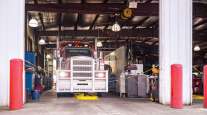Career Pathways Are Evolving
In today’s data-driven world, where much of fleet management strives to solve all of its problems strictly by the numbers, consider the following truth: Data does not fix anything.
Data is like a hunting dog. It just points you to the fowl. You take aim, shoot with buckshot and the dog retrieves the fallen target. That being said, fleet managers still need to know how to address complaint, cause and correction with a root-cause solution centered on the basics of maintenance — skills not yet forgotten by today’s doctors of iron but may well become a lost art to tomorrow’s caretakers of equipment.

Stuart
The trucking industry certainly is no stranger to change, but the pace of recent technological progress has been unprecedented.
Automated vehicles and platooning, aftertreatment systems, telematics, sensor-based maintenance, data mining and increasing vehicle complexity — to name a few examples — are among a growing list of items with which today’s fleet executives must wrestle.
The rapid pace of change and the means by which fleet managers make decisions on vehicle specifications, maintenance and operational issues is revolutionizing how fleet executives function. Savvy industry professionals are keeping pace with the times, while those resistant to change run the risk of being left behind and unemployed. Midcareer professionals unable to adapt will face the reality of a forced career change at a time in life when it is most difficult to pivot successfully.
What was once expected of fleet vice presidents and directors of maintenance is quietly evaporating and becoming past tense. The days where one maintenance executive is responsible for purchasing, maintenance, parts and specification are over in many fleets. Instead, these responsibilities are being redistributed into corporate silos. Seasoned fleet professionals have a wealth of information to share. The trick is speaking the language of a new generation of fleet owners and data professionals so that the information is heard and valued.
What is expected of fleet executives, managers and supervisors is changing. Are you ready for the big shift? What fleet professionals of the past, present and future should expect in the coming years is changing, and what different skills they need to employ to remain effective for the beginning, middle and end of their careers is not always certain.
The new management philosophies are much different today — driven by data, key performance indicators, big data and bigger data.
There is nothing wrong with data. Fleets need it. In fact, American Trucking Associations’ Technology & Maintenance Council has been a pioneer in encouraging management’s utilization of data in fleet operations through the development of the Vehicle Maintenance Reporting Standards (VMRS) going as far back as 1969.
But the difference today from earlier years is that the industry’s doctors of iron took what I believe was a more holistic approach to solving fleet problems through both tactile and statistical means.
Have Maintenance Managers Found New Ways to Fix Trucks?
Maintenance managers always are being controlled by the bean counters, and in some cases, they need to be. There is no question as to the value of measuring cash in and cash out, adhering to a sound business plan of income and expenses.
Smart fleets do leverage VMRS. If properly utilized, VMRS can help fleets account for the totality of their maintenance expenses. From there, you just need to select a common denominator to which you want to measure your operation. At the highest level, costs are measured by general ledger accounting, established by how finance wants to code expenses for payment, with the top level executives wanting to see it in a much simpler, nondiluted form.
New, aggressive approaches to controlling maintenance costs are becoming more common than in years’ past. Those who do not understand and/or accept that costs are going through the roof for tires, aftertreatment systems, labor and parts— thanks to increasing vehicle complexity — are not long for this industry. Maintenance managers can no longer rely simply on familiar solutions to reduce or maintain costs. For some veterans, it has gotten to a point of almost no control.
For the past 25 years, managers of iron have found ways to reduce cost because they were compelled to do so to keep their jobs. They had to be creative and cut to stay alive. They had to use data to learn where their costs were hiding. But we have now cut to the bone, and today’s equipment is not what it once was.
A new generation of fleet executives has emerged who are quite skilled at generating charts, graphs, Gantt charts, fishbone diagrams and other benchmarking tools. But have they really found new ways to fix trucks? In some cases, they’re great at measuring but have no experience in how to fix the root causes of what really costs our industry — downtime.
Consider, for example, this short story: A new “30,000-foot” manager is hired into a company and saddled with the maintenance department, management of which is not his forte.
This person’s strength is organization from behind the desk and charts on the wall, hired by a like-minded and similarly skilled owner whose thought process also is driven exclusively by numbers, and has been unhappy for years with the condition of the fleet, maintenance facility costs and customer disruptions.
The new manager’s style and approach is to measure, chart and graph, and the manager’s boss is happy because now they both can look at the same reports and both conclude that the costs are too high and not meeting the budget. The end result is drive cost out without really determining where the maintenance money is being spent; in this case, a rapidly aging fleet of vehicles for which no sensible replacement schedule is anticipated. Spend time to better specify the truck and find out why breakdowns are actually happening? That would cost too much.
My point is, our industry is getting to a point where too often no one cares or knows about how to fix trucks. They just know how to measure the problem.
I want to salute all those who understand both measuring and fixing — both data and iron. They are the ones who truly can control costs — not simply manage numbers to make themselves look good for short-term gain.
At TMC’s 2018 annual meeting, I moderated a technical session featuring a panel of “old school“ and “new school“ fleet executives who shared with attendees what they believed were the best approaches to equipment management for today and tomorrow’s fleets. Some takeaways from that session: First, traditional doctors of iron cannot rely solely on experience and intuition to manage today’s fleets. The complex nature of equipment demands a greater level of management supported by the vehicle data itself and the support systems that collect that data. Second, data alone is insufficient. The new generation of fleet managers must understand it is not enough to quantify the maintenance challenge; they must understand how the vehicle functions in its operating environment to intelligently correct failures and keep them from re-occurring.
The successful fleet manager of tomorrow will be able to straddle both worlds. Those who cannot will find themselves in need of an entirely new career pathway.
Darry Stuart is a past general chairman and treasurer of American Trucking Associations’ Technology & Maintenance Council. He is president and CEO of the Wrentham, Mass.-based DWS Fleet Management Services and a recipient of TMC’s highest honor — the Silver Spark Plug.




